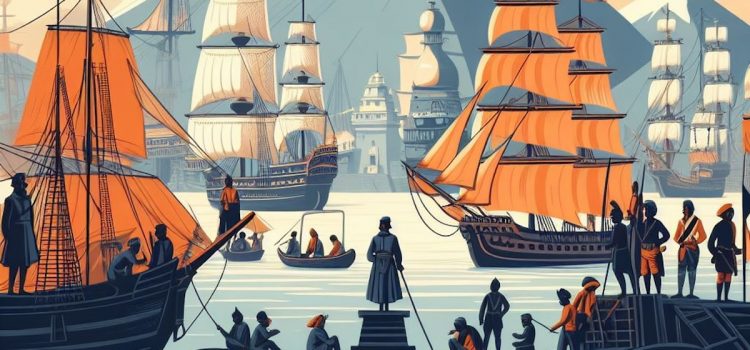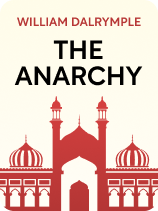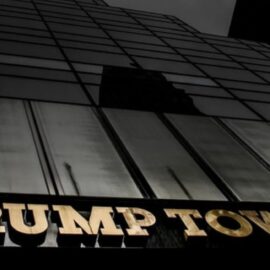

This article is an excerpt from the Shortform book guide to "The Anarchy" by William Dalrymple. Shortform has the world's best summaries and analyses of books you should be reading.
Like this article? Sign up for a free trial here.
How did England’s East India Company get so powerful? How did it pave the way for colonial rule in India?
In his book The Anarchy, historian William Dalrymple traces the ascent of the English East India Company. Originally a modest group of traders, the company transformed over the 17th and 18th centuries into an imperial powerhouse that imposed British rule across the Indian subcontinent.
Continue reading to learn about the fascinating rise of the East India Company.
Setting the Stage (Early 17th to Mid 18th Centuries)
To chart the rise of the East India Company, we’ll start with some context on conditions in India during the 17th century and what made it so attractive to British merchants. First, we’ll discuss how England took notice of the wealth in India and began trading within the powerful Mughal empire. Then we’ll explore the collapse of this empire, which created the conditions for the EIC’s rise.
England Sets Its Sights on India’s Wealth
Dalrymple explains that English traders were attracted to India’s vast wealth. By the 16th and early 17th century, the Mughal empire in India was one the richest on earth, second only to Ming China. The Mughals were a powerful Muslim ruling class that governed most of what’s now modern India through a network of tax collectors and officials backed by vast armies. Nobles, called Nawabs, ruled individual provinces and sent tribute back to the capital in Delhi. With India’s fertile soil for agriculture, vast workforce, and highly developed culture of artisans, the Mughal empire had become a major exporter of textiles and spices.
(Shortform note: The Mughals originally arrived in India from central Asia during the early 16th century. (“Mughal” is the Indo-Aryan equivalent of “Mongol.”) Historians attribute the founding of the Mughal empire to Zahir-ud-din Mohammad Babur—a descendant of both Ghengis Khan and the Mongol conqueror Timur who was born in Uzbekistan. Babur founded the Mughal empire in 1526. Based mostly in Northern and Western India, the early Mughal empire also included parts of modern-day Afghanistan and Pakistan.)
For centuries, the flow of international trade had brought gold, silver, and jewels into India in exchange for their exported goods, some of which made their way to Europe by trade routes through the Middle East. However, the price of these goods increased significantly as they progressed along the trade routes, and the goods that did reach Europe were exceedingly rare. Therefore, European traders stood to gain enormous profits by trading with India directly and cutting out the traders in between.
(Shortform note: Most of India’s wealth flowed from the spice trade, a vast network of land and sea routes connecting Indonesia, China, India, the Middle East, Eastern Africa, and Europe. The earliest known evidence of these routes goes back to 2,000 BCE, when cinnamon and cassia from Sri Lanka and China reached the Arabian Peninsula. India has been heavily involved in this trade route since at least 1,000 BCE, when cinnamon and other spices reached as far west as Egypt. Direct trade between India and Europe first began around 120 BCE, when Greek and Roman ships began navigating to India. However, these trade routes broke down with the collapse of the Roman Empire and the rise of the Arabic and Ottoman Empires who successfully monopolized these routes.)
The Spanish, Portuguese, and Dutch took advantage of this opportunity first, and Dalrymple characterizes the English as latecomers trying to catch up. The EIC formed to trade with India in 1600. Queen Elizabeth I signed its charter, granting a trade monopoly that excluded rival English merchants over most of Eastern and southern Asia.
(Shortform note: Exclusive trade monopolies were standard policy for England and most of Europe at this time. Following a philosophy now called “mercantilism,” monopolies were granted based on the belief that consolidating economic power in fewer hands would strengthen nations and the monarchs who ruled them. It wasn’t until the late 18th century that economists like Adam Smith began popularizing the idea of market competition in Western economic thought.)
Britain Sets Up Shop In Mughal India
Dalrymple asserts that in the 17th century, the EIC was constrained by the power of the Mughals and carefully deferred to their authority. The EIC secured rights to build trading forts only after King James I of Great Britain sent an envoy to negotiate with the Mughal emperor Jahangir. Jahangir saw trade with Britain as a low priority. He rejected the company’s bid for an exclusive trade deal that would exclude Britain’s European rivals, but he eventually granted permission to trade.
(Shortform note: Jahangir’s foreign policy focused largely on maintaining relationships with the large Islamic empires to his West: the Ottomans, Uzbeks, and Persians. The Mughals fought the Persians during Jahangir’s reign, negotiating a peace treaty after conceding the city of Kandahar. Jahangir considered an alliance with the Ottomans and Uzbeks to counter Persian power, but he died before he could carry out his plan. Jahangir likely saw foreign relations with Britain as a low priority because the distant island nation was mostly uninvolved in the conflicts that defined his foreign policy concerns.)
Throughout the 17th century, the EIC carried out trade and quietly built more trading forts along the shores of India while remaining deferential to Mughal rule. Dalrymple explains that the Mughals commanded enormous armies and the British were in no position to cross them. The British took military action against the Mughals only once during this time. The Mughals retaliated by seizing most of the British forts, and the EIC had to apologize and renegotiate permission to continue trade.
(Shortform note: From the 15th through the 17th centuries, European nations conducted most of their overseas trade through seaside forts, which were known as “factories” at the time. These fortified locations provided markets, warehouses, customs, defense, and even governance for European merchants and explorers. Though they were established under the rule of local nations, historians now see these forts as the precursors to European colonialism in Africa, Asia, and the Americas.)
The Mughal Empire Begins to Collapse
Around the early 18th century, the Mughal empire began to collapse. Dalrymple attributes this collapse to a wide range of forces. First, Mughal Emperor Aurangzeb began enforcing a stricter version of Quranic law, angering the Hindu majority. Then rebellions intensified throughout the empire, as Sikhs, Afghans, and Hindus began seizing territory.
(Shortform note: Many historians argue that Aurangzeb’s crackdown on non-Muslim religions contributed significantly to the empire’s decline because it represented such a hard reversal of the religious tolerance of his predecessors. Many of the Mughals not only tolerated a wide range of religious practices in their kingdoms, but hosted interfaith dialogues between Muslims, Hindus, Christians, Jains, and Zoroastrians. They also subsidized the translation of holy texts. Many Mughal nobles also personally practiced a syncretic form of Islam that recognized commonalities with Hinduism and allowed them to participate in Hindu festivals.)
After Aurangzeb’s death in 1707, a dispute broke out over who would succeed him, leading to assassinations, rapid turnover, and conflict between competing Mughal factions. Then a Persian general ransacked the capital of Delhi in 1739, depleting their treasury and damaging the Mughals’ reputation for power. One by one, provincial rulers—the Nawabs—began cutting ties with the capital. The independent provinces stopped sending tribute, undermining the empire’s finances. This fractured India into competing regional powers, inaugurating a period of war and instability.
The Company Rises to Power in Bengal (Early to Mid-18th Century)
While the EIC didn’t cause the collapse of the Mughal empire, Dalrymple asserts that it became the primary beneficiary. No longer constrained by the powerful Mughals, the EIC expanded its trading operations and military capacity, adding forts and recruiting locals to serve as infantry. The EIC set its sights on Bengal, a wealthy province on India’s northeastern coast. We’ll explore the series of events that allowed the EIC to take advantage of political chaos to rise to power in Bengal.
(Shortform note: Historians attribute Bengal’s wealth to a vibrant combination of industries, including textiles, shipbuilding, grains, fruits, and finance. Mughals conquered the region during the 16th and 17th centuries and built up its economy by clearing jungles and importing laborers for agriculture.)
Event #1: The English East India Company Challenges the Ruler of Bengal
The EIC began its rise to power in Bengal by first building up military capacity and then challenging the Mughal rulers. Here we’ll discuss these two key developments.
1) The Company Builds Up Military Capacity
Dalrymple states that the EIC originally began building up military capacity in Bengal to counter the French colonists, who had also been building capacity in the region. The British government sent military forces to India that were placed under the command of the EIC. This mutual arms race broke out into a series of wars between the EIC and the French in India called the Carnatic Wars. The British eventually prevailed against the French, establishing their dominance among European powers in the region.
However, this military buildup led to tensions with the Mughal rulers of Bengal. The Mughals didn’t approve of European colonists militarizing, and Siraj ud-Daula, the Nawab of Bengal at the time, called on both the British and French to disarm. The French responded diplomatically, diffusing tensions. On the other hand, the EIC responded defiantly, escalating tensions. Siraj attacked the British in response, capturing their fort in Calcutta and imprisoning British soldiers.
(Shortform note: The Carnatic Wars were part of a much larger conflict between Britain and France called the Seven Years’ War. In Europe, an alliance between Britain and Prussia fought against an alliance between France and Spain over an Austrian succession dispute. The British also fought against France in North America (in an event sometimes called the French and Indian War) and against Spain in the Caribbean. The Seven Years’ War concluded in victory for Britain and its allies, cementing Britain’s position as a global superpower.)
2) The Company Retaliates Against Siraj ud-Daula
As Dalrymple narrates, the EIC retaliated against the Mughal prince with a successful military campaign that expanded its influence. A young military commander named Robert Clive convinced the EIC board to formally declare war on Siraj. After a decisive battle where Siraj barely escaped with his life, the Nawab negotiated a treaty with the British. The EIC pressed for enormous privileges. As a condition of his surrender, Siraj let the EIC keep its forts, freed its goods of taxes, and allowed it to create its own mint and currency.
(Shortform note: As a joint-stock company, the EIC was governed by a board of directors who were elected by the company’s shareholders. However, the directors were based in London and relied on infrequent reports from overseas. Thus they exercised little influence over the company’s daily operations, giving the officers and merchants in India wide latitude over decision-making. The fact that Clive had to run his declaration of war through the board of directors underscores the significance of this change in company policy from the deference to Mughal authority practiced in the 17th century.)
Event #2: The English East India Company Backs a Coup
Emboldened by its victory against Siraj, the EIC sought to expand its influence in Bengal by backing a coup in Bengal and installing a puppet ruler who would support its interests. Dalrymple explains that Mir Jafar, one of Siraj’s generals, planned to overthrow the Mughal prince and was looking for allies. The EIC was known throughout Bengal for its military prowess, and the Jagat Seths, a wealthy family of financiers, offered a vast sum of money to the EIC and Clive if they’d join Jafar in the coup. The EIC agreed, and Clive marched on the capital of Bengal with a force of English soldiers and sepoys—Indians who had been recruited into the company army and trained in British weaponry and tactics.
In its coup against Siraj, the EIC benefited from gaps in the other side’s military technology and experience with firearms—for example, EIC fighters knew to keep their gunpowder dry during a rainstorm with tarps, while their opponents, unfamiliar with firearms and their maintenance, didn’t. After defeating Siraj, the EIC installed Jafar as the Nawab of Bengal, but his dependence on EIC military power made the British the de facto rulers of the province. The Jagat Seths made good on their payment to Robert Clive, who returned to England the richest man in the country.
Bengal Under Jafar and the EIC
Dalrymple reports that the newly-installed Nawab Jafar’s reign went poorly. He had little legitimacy in the eyes of the Bengali citizenry—he’d never been a Mughal prince and had seized power in a violent coup with the help of foreign merchants. Furthermore, having spent his entire career in the military, Jafar had little aptitude for governing, and his administration was beset by financial problems. Jafar’s soldiers grew mutinous since he could no longer pay them.
The EIC benefited enormously from Jafar’s ineffectual rule. Without checks on its power, the EIC oppressed the Bengali population with impunity. The company extorted merchants into selling goods at unfair prices, and its soldiers bullied, robbed, and arrested Bengali citizens.
(Shortform note: Dalrymple attributes many of Jafar’s financial problems to mismanagement and lack of governing experience. However, others looking back at this time have highlighted the exorbitant payments made to Clive and the EIC for their role in the coup, which cleaned out much of the royal treasury and put Jafar’s regime on a shaky footing from the outset.)
Event #3: The English East India Company Backs Another Coup
While the EIC enjoyed its impunity, the Jagat Seths were not pleased with Jafar’s flailing regime and decided to back a second coup. Dalrymple explains that Jafar had an ambitious son-in-law named Mir Qasim who thought he could do better. The Jagat Seths approved of him and asked the EIC to reprise its mercenary role. The EIC agreed. But, this time, instead of a lump sum of cash, it asked for tax collection rights in several portions of Bengal. This effectively made it an independent governing force with a steady stream of revenue. Qasim and the Jagat Seths agreed to these terms, and the EIC deposed its own puppet Jafar in a second coup.
The EIC Legitimizes Its Coups
Dalrymple notes that, though the EIC had now carried out two successful coups, it still faced a significant gap in legitimacy. Fortunately for the company, a potential ally had made his way to Bengal and was interested in talks. Shah Alam was a young Mughal prince who had been heir to the throne in Delhi before being ousted by his cousin in a succession dispute. After Alam narrowly escaped an assassination attempt, a romantic legend sprang up around the exiled young prince, and he attracted thousands of followers who considered him the true heir to the Mughal throne. While the EIC had power without legitimacy, Shah Alam had legitimacy without power. Their complementary needs suggested a natural alliance.
The EIC and Shah Alam reached an agreement: The EIC and Mir Qasim would pledge their allegiance to Alam as the true heir of the Mughal empire. Alam would formally recognize Qasim as the legitimate ruler of Bengal, legitimizing both coups. Then, the EIC would use its military forces to help the young prince march on Delhi and take back his throne. However, after Alam legitimized the coups, the EIC dragged its feet on its end of the bargain. Frustrated with his new “allies,” Shah Alam left Bengal to join forces with Shuja ud-Daula, a Mughal prince ruling a neighboring kingdom.
Event #4: The English East India Company Overthrows Mughal Rule in Bengal
Dalrymple says the EIC soon grew tired of Qasim’s rule. A much more effective ruler than his father-in-law, Qasim raised taxes to balance the budget and pay soldiers their back wages. He rooted out corruption and built a strong administrative state. Qasim’s competence made him much harder to push around, and the EIC missed the impunity it had enjoyed under Jafar. Additionally, Qasim recognized the EIC as a rival and sought to counter its influence by eroding the privileges it had obtained from Siraj. The EIC voted to formally declare war on Qasim and reinstate Mir Jafar as Nawab of Bengal. Its military campaign prevailed and drove Qasim out of the region.
Event #5: The English East India Company Repels a Mughal Alliance
According to Dalrymple, the EIC would face one more challenge to establishing complete rule in Bengal: an alliance between three Mughal princes. After his defeat, Qasim fled Bengal with his remaining forces and, like Shah Alam, sought refuge with Shuja ud-Daula. He then proposed an alliance between himself, Shuja, and Shah Alam to drive out the English.
The three princes assembled an enormous force and marched toward Bengal. However, the EIC managed to repel their attack, largely due to a crack in the princes’ alliance. Dalrymple explains that Shah Alam wasn’t fully committed to the alliance. Since Qasim and the EIC had both declared allegiance to him, the young prince saw this as merely a dispute between his subjects—and secretly remained in communication with the EIC. Thus, while Shuja’s troops charged into battle, Shah Alam’s held back, and Shuja’s army failed to defeat the EIC on its own. With the alliance fragmented, the EIC launched a successful counteroffensive and defeated Shuja’s army, cementing its rule in Bengal.

———End of Preview———
Like what you just read? Read the rest of the world's best book summary and analysis of William Dalrymple's "The Anarchy" at Shortform.
Here's what you'll find in our full The Anarchy summary:
- The rise of the English East India Company during the 17th and 18th centuries
- How a trading company came to rule most of the Indian subcontinent
- The background, historical context, and fallout from the events in the book






